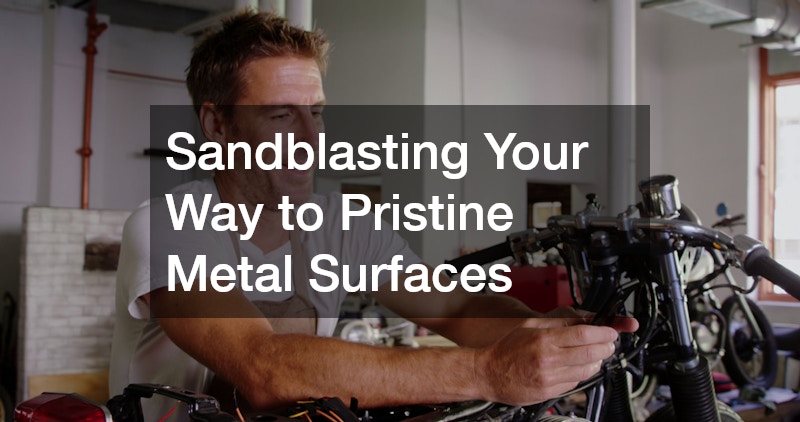
Achieving perfectly smooth, clean metal surfaces is essential for both aesthetic and functional purposes. Sandblasting offers a reliable method for removing rust, old paint, and surface contaminants while preparing metal for further treatments like painting or coating. This process, which involves propelling abrasive materials at high speed against a surface, allows for precise and thorough cleaning, making it a preferred choice in many industrial and commercial applications.
By understanding the principles and techniques behind this method, operators can ensure superior results while extending the life of metal components.
The process is not just about removing imperfections; it is also about improving the overall integrity of metal surfaces. By using controlled pressure and the appropriate abrasive material, even complex shapes and hard-to-reach areas can be treated effectively. It also creates a slightly textured finish that enhances paint adhesion or coating durability, making subsequent treatments more successful. Businesses that prioritize high-quality surface preparation often see long-term benefits in both appearance and performance.
Understanding Sandblasting and Its Benefits
This surface finishing technique uses high-velocity particles to clean, shape, or smooth metals. It is widely recognized for its ability to remove rust, paint, and scale, restoring materials to a near-original state. Beyond cleaning, it can improve the structural integrity of metal by eliminating weak surface layers and creating a uniform texture for coatings or finishes. Its versatility makes it applicable in industries ranging from automotive restoration to construction and manufacturing.
The benefits extend beyond mere cleaning. By selecting the correct abrasive material and adjusting the pressure and technique, operators can achieve a variety of surface profiles suited to specific needs. Heavily corroded steel beams can be restored, while delicate aluminum components can be treated gently to preserve their structural properties. This method also accelerates preparation for coatings, reducing the risk of peeling, flaking, or uneven finishes, which is critical in environments that demand both durability and visual appeal.
Choosing the Right Abrasive Materials
Selecting the proper abrasive is crucial to achieving desired results. Abrasives vary in hardness, shape, and size, and each interacts differently with metal surfaces. Common options include aluminum oxide, glass beads, silicon carbide, and steel grit. The choice depends on metal type, surface condition, and intended finish, as some are better for heavy material removal while others provide a smoother texture. Understanding these distinctions optimizes both efficiency and quality.
In practical terms, aluminum oxide works well for high-strength metals because it removes rust and coatings without excessive surface damage. Glass beads are preferred for delicate metals or decorative finishes, producing a uniform matte texture. Steel grit provides aggressive cleaning for industrial-grade steel but requires careful handling to avoid over-abrading. Matching abrasives to specific surfaces ensures effective and controlled results.
Preparing Metal Surfaces for Sandblasting
Proper surface preparation ensures optimal outcomes. This includes removing loose debris, oil, and grease that can interfere with the abrasive process. Preparation also involves assessing metals for weak spots, corrosion, or previous coatings requiring different approaches. A well-prepared surface allows the abrasive to contact the metal evenly, enhancing efficiency and the longevity of subsequent coatings.
Specific steps may vary depending on the project. Heavily rusted areas or peeling paint might first need scraping or rust treatment. Sensitive components should be masked or protected to prevent damage. Surfaces must also be dry and free from contaminants to avoid uneven etching or pitting. Combining these preparatory measures with proper safety practices produces clean, uniform surfaces ready for finishing.
Techniques for Effective Sandblasting
Several techniques can achieve the best results depending on surface size, shape, and material hardness. Common methods include direct blasting, holding the nozzle perpendicular to the surface, sweeping, moving the nozzle in a controlled pattern to avoid over-abrasion, and automated blasting for large-scale or repetitive tasks. Each requires skill to maintain consistent coverage and prevent surface damage.
Operators adjust nozzle distance, pressure, and angle to suit the metal. Tight corners or intricate patterns may require smaller nozzles and lower pressures to prevent deformation, while large flat surfaces can withstand higher pressures. Skilled use ensures uniform results, reduces material waste, and minimizes defects such as uneven textures or micro-scratches. Precision and control are key to success.
Maintaining and Protecting Finished Surfaces
After treatment, proper maintenance and protection preserve results. Metal exposed to air or moisture can quickly oxidize, so immediate treatment with primers, coatings, or sealants is necessary. Regular inspections and touch-ups identify areas of wear or corrosion before they become major issues. Maintenance protects aesthetics and extends the life and performance of metal components.
Protective strategies vary depending on the environment and use. Industrial machinery may require durable coatings resistant to abrasion and chemicals, while decorative metalwork benefits from clear coats or specialized finishes that enhance shine. Proper storage and handling also help, keeping surfaces dry and free from contaminants. Combining finishing techniques with ongoing care keeps metal surfaces pristine and functional for years.
This method is a powerful tool for restoring, cleaning, and preparing metal surfaces across diverse applications. Its versatility, precision, and efficiency make it essential where surface quality is critical. By understanding the benefits, selecting the right abrasives, preparing surfaces properly, applying effective techniques, and maintaining finished metal, operators achieve results that are both durable and visually appealing.

